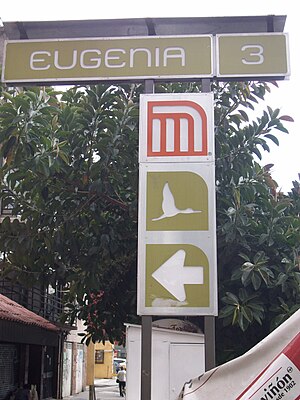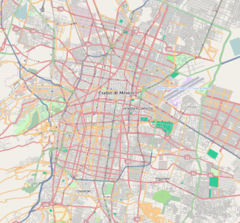Eugenia metro station
| STC rapid transit | |||||||||||
 | |||||||||||
| General information | |||||||||||
| Location | Av. Cuauhtémoc and Eje 5 Sur Eugenia, Mexico City Mexico | ||||||||||
| Coordinates | 19°24′24″N 99°09′21″W / 19.406637°N 99.155753°W | ||||||||||
| Line(s) | |||||||||||
| Platforms | 2 side platforms | ||||||||||
| Tracks | 2 | ||||||||||
| Connections | |||||||||||
| Construction | |||||||||||
| Structure type | Underground | ||||||||||
| History | |||||||||||
| Opened | 25 August 1980 | ||||||||||
| Passengers | |||||||||||
| 2021 | 2,823,476[1] | ||||||||||
| Rank | 115/195[1] | ||||||||||
| Services | |||||||||||
| |||||||||||
| |||||||||||
Eugenia is a metro station along Line 3 of the Mexico City Metro.[2][3] It is located in the Colonia Vertiz Narvarte and Colonia del Valle neighbourhoods of the Benito Juárez borough of Mexico City.[2]
The station logo depicts a stork, and its name refers to the avenue above the station.[2][3] The name Eugenia literally means "The well born", so the stork is a birth symbol. The station opened on 25 August 1980.[4]
Until trolleybus service was discontinued in 2010,[5] this metro station offered transfers to the "O" line of the trolleybus, which ran between Metro San Antonio and Central de Abasto wholesale market located in Iztacalco borough.[6]
Eugenia serves the Vertiz Narvarte and del Valle neighborhoods.[2] It is located at the crossing of Eje 5 Sur Eugenia and Avenida Cuauhtémoc.[2]
Ridership
| Annual passenger ridership | |||||
|---|---|---|---|---|---|
| Year | Ridership | Average daily | Rank | % change | Ref. |
| 2021 | 2,823,476 | 7,735 | 115/195 | −20.91% | [1] |
| 2020 | 3,569,934 | 9,753 | 104/195 | −46.72% | [7] |
| 2019 | 6,700,579 | 18,357 | 97/195 | +0.09% | [8] |
| 2018 | 6,694,794 | 18,341 | 95/195 | +0.53% | [9] |
| 2017 | 6,659,665 | 18,245 | 96/195 | −0.92% | [10] |
| 2016 | 6,721,700 | 18,365 | 99/195 | +0.78% | [11] |
| 2015 | 6,669,576 | 18,272 | 98/195 | +0.17% | [12] |
| 2014 | 6,658,355 | 18,242 | 104/195 | −0.80% | [13] |
| 2013 | 6,711,970 | 18,388 | 100/195 | −11.62% | [14] |
| 2012 | 7,594,542 | 20,750 | 89/195 | −5.94% | [15] |
| 2011 | 8,074,037 | 22,120 | 88/175 | +28.45% | [16] |
| 2010 | 6,285,519 | 17,220 | 90/175 | – | [17] |
References
- ^ a b c "Afluencia de estación por línea 2021" [Station traffic per line 2021] (in Spanish). Sistema Transporte Colectivo Metro. 2020. Archived from the original on 7 March 2022. Retrieved 7 March 2022.
- ^ a b c d e "Eugenia" (in Spanish). Sistema de Transporte Colectivo. Archived from the original on 10 October 2011. Retrieved 20 August 2011.
- ^ a b Archambault, Richard. "Eugenia - Mexico City Metro System". Retrieved 20 August 2011.
- ^ Monroy, Marco. Schwandl, Robert (ed.). "Opening Dates for Mexico City's Subway". Retrieved 14 August 2011.
- ^ "Servicios.- Servicio de Transportes Eléctricos del D.F.: Líneas de Trolebuses" (in Spanish). Servicio de Transportes Eléctricos. Archived from the original on 27 September 2011. Retrieved 20 August 2011.
- ^ "Servicios.- Servicio de Transportes Eléctricos del D.F.: Línea: O LINEA O" (in Spanish). Servicio de Transportes Eléctricos. Archived from the original on 6 August 2011. Retrieved 20 August 2011.
- ^ "Afluencia de estación por línea 2020" [Station traffic per line 2020] (in Spanish). Sistema Transporte Colectivo Metro. 2021. Archived from the original on 21 June 2021. Retrieved 21 June 2021.
- ^ "Afluencia de estación por línea 2019" [Station traffic per line 2019] (in Spanish). Sistema Transporte Colectivo Metro. 2020. Archived from the original on 8 April 2020. Retrieved 3 May 2020.
- ^ "Afluencia de estación por línea 2018" [Station traffic per line 2018] (in Spanish). Sistema Transporte Colectivo Metro. 2019. Archived from the original on 6 June 2019. Retrieved 7 April 2020.
- ^ "Afluencia de estación por línea 2017" [Station traffic per line 2017] (in Spanish). Sistema Transporte Colectivo Metro. 2019. Archived from the original on 3 May 2020. Retrieved 3 May 2020.
- ^ "Afluencia de estación por línea 2016" [Station traffic per line 2016] (in Spanish). Sistema Transporte Colectivo Metro. 2017. Archived from the original on 3 May 2020. Retrieved 3 May 2020.
- ^ "Afluencia de estación por línea 2015" [Station traffic per line 2015] (in Spanish). Sistema Transporte Colectivo Metro. 2016. Archived from the original on 3 May 2020. Retrieved 6 May 2020.
- ^ "Afluencia de estación por línea 2014" [Station traffic per line 2014] (in Spanish). Sistema Transporte Colectivo Metro. 2015. Archived from the original on 3 May 2020. Retrieved 6 May 2020.
- ^ "Afluencia de estación por línea 2013" [Station traffic per line 2013] (in Spanish). Sistema Transporte Colectivo Metro. 2014. Archived from the original on 3 May 2020. Retrieved 6 May 2020.
- ^ "Afluencia de estación por línea 2012" [Station traffic per line 2012] (in Spanish). Sistema Transporte Colectivo Metro. 2013. Archived from the original on 3 May 2020. Retrieved 6 May 2020.
- ^ "Afluencia de estación por línea 2011" [Station traffic per line 2011] (in Spanish). Sistema Transporte Colectivo Metro. 2012. Archived from the original on 6 May 2020. Retrieved 6 May 2020.
{{cite web}}:|archive-date=/|archive-url=timestamp mismatch; 7 May 2020 suggested (help) - ^ "Afluencia de estación por línea 2010" [Station traffic per line 2010] (in Spanish). Sistema Transporte Colectivo Metro. 2011. Archived from the original on 6 May 2020. Retrieved 6 May 2020.
{{cite web}}:|archive-date=/|archive-url=timestamp mismatch; 7 May 2020 suggested (help)
External links
 Media related to Eugenia (station) at Wikimedia Commons
Media related to Eugenia (station) at Wikimedia Commons The dictionary definition of Eugenia at Wiktionary
The dictionary definition of Eugenia at Wiktionary


